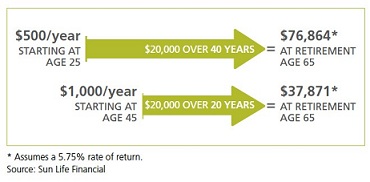Looking at retirement
Please note that once you've submitted your retirement notice, the Corporation will consider your decision as final, and any exceptional circumstances will need to be reviewed by Human Resources.
Start planning your retirement today
| Early career | Have a savings plan and start putting money aside for retirement. The earlier you begin to save, the more financially secure you will be in retirement.

|
||||||||
| Mid-career | Start planning what you want to do during your retirement – will you pursue a hobby, travel, volunteer or work part-time. This will help you with your planning. Example: Paul is in mid-career and he wants to pursue his hobby of woodworking when he retires. His daughter has just bought a house and he plans to help her with some renovations. Paul’s desired monthly retirement income in today’s dollars is $3,210 per month, approximately 70 per cent of what he currently earns. Paul expects to receive the following retirement income. Yearly gross income before retirement Planned retirement income (70% of current income)
Paul will need to save approximately $14,000* in today’s dollars to receive $79* per month starting at age 65. *These numbers are used for illustration purposes only and are based on the maximum benefits for 2012 for the CPP and OAS. |
||||||||
| Late-career | Fine tune your financial preparations so you can achieve your lifestyle plan. Begin to enjoy the activities you have planned for a smooth transition to retirement. |
Financial and retirement planning facts
Recent reports suggest that nearly a third of young Canadians have not saved any money for retirement, even though many say they want to leave the workforce before age 60. The reality is that Canadians are living longer and spending more time in retirement.
Your retirement income can come from three sources
| Employer |
|
| Government |
|
| Personal |
|
How much do I need to retire?
It depends on how you want to spend your time in retirement. While some expenses typically disappear in retirement (e.g. mortgage payments), other expenses, such as travel or leisure, often increase. Many financial planners estimate that you will need 60 to 80 per cent of pre-retirement earnings to maintain the same lifestyle after you retire.
You can calculate how much you can expect to receive from all retirement income sources, including CPP/QPP and OAS, your Canada Post pension and other employer-sponsored pension plans, and your personal savings, with Service Canada’s Canadian Retirement Income Calculator.
You may wish to discuss your retirement plans and retirement planning options with a personal financial advisor. You are responsible for any costs associated with seeking such advice. If you don’t have a financial advisor, the Employee Assistance Program (EAP) can help you.
